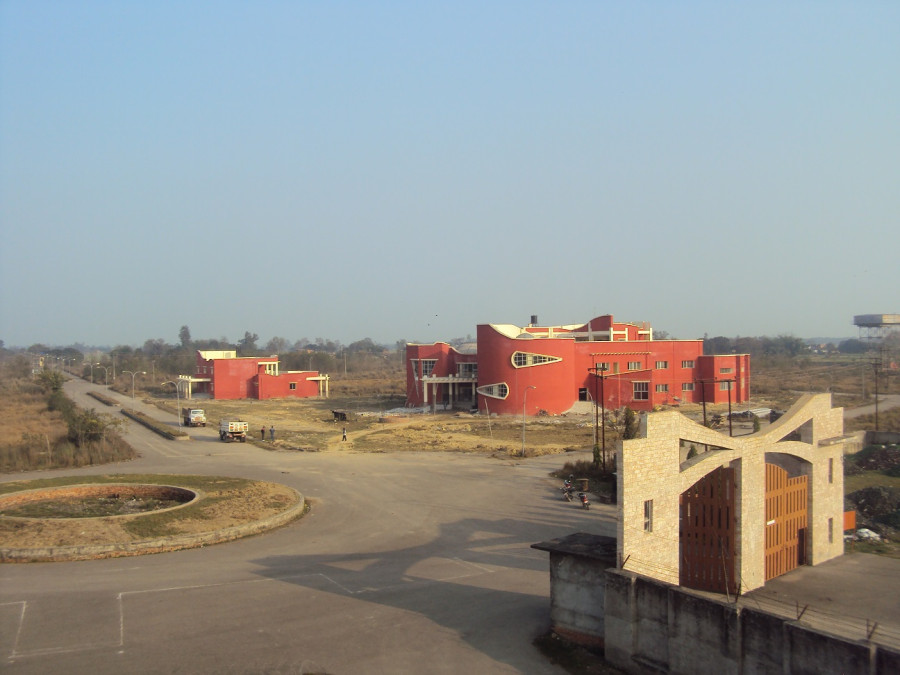Money
Bhairahawa special economic zone slashes rentals by half
There are few takers for the industrial plots at the export-oriented enclave, and the estate lies semi-completed even though many ministers have come and gone.
Krishana Prasain
The government has slashed rentals by half at the special economic zone in Bhairahawa in a bid to lure investors to set up factories there.
This is the second rent cut in six years following complaints that it was too high. Potential entrepreneurs do not seem to be impressed by the facilities promised at the industrial estate, and vast tracts lie empty.
Established nearly two decades ago in a bid to promote exports by streamlining services and utilities, the country's first special economic zone is known more for its vacant lots than humming manufacturing plants.
Chandika Prasad Bhatta, executive director of the Special Economic Zone Authority, told the Post they had decided to halve the monthly rent to Rs10 per square metre.
“The revised rate will come into effect within 15 days, pending approval by the Special Economic Zone Board.”
The government last reduced the rent in March 2016 when the Cabinet approved a steep cut from Rs150 per square metre to Rs20. The Special Economic Zone Authority, which operates the site, falls under the jurisdiction of the Ministry of Industry, Commerce and Supplies.
At that time, high rental charges had been blamed for the reluctance of companies to install production plants inside the special zone. But the private sector thinks it is still too high.
“The revised rent of Rs10 per square metre is still expensive,” said Dinesh Shrestha, vice-president (industry) of the Federation of Nepalese Chambers of Commerce and Industry.
“The rental rate should be nominal to promote industry and generate jobs. The government should not look at commercial benefits all the time,” he said.
The much-hyped Bhairahawa special economic zone located in south central Nepal was built in 2003, and its administrative building was inaugurated in November 2014, that is, a full 11 years after construction started, by the then deputy prime minister and home minister Bam Dev Gautam and industry minister Mahesh Basnet.
In 2017, the then industry minister Nabindra Raj Joshi inaugurated the facility for the second time.
The facility is spread over 52 bighas, and contains 69 industrial plots ranging in area from 1,400 to 3,700 square metres.
There are few takers for the industrial plots at the export-oriented enclave, and the estate lies semi-completed even though many ministers have come and gone in these years.
Bhatta admits that the special economic zone has not been providing one-stop service as touted.
"Different government bodies like the Department of Industry, Office of the Company Registrar and Department of Customs provide services to industries, but they do not have offices inside the special economic zone," said Bhatta.
He added that the government had launched several measures to attract businesses inside the zone by giving them full or partial discounts on customs duty on raw materials and income tax. Even then, the facility has not been able to attract investors.
Many entrepreneurs have cancelled their agreements to operate plants, complaining that even the minimum infrastructure was not available.
“Obviously, there is poor coordination between the zone authority and other government bodies, resulting in problems and hassles for those desiring to open factories inside the zone,” Shrestha said.
“The major problem is that banks do not value the companies located inside the zone for issuing loans and other purposes,” Shrestha said.
Factories housed in the zone are required to export at least 60 percent of their output, according to the Special Economic Zone Act.
"This compulsory provision also discourages entrepreneurs from opening factories as it is a tall order, and exportable items have not been identified yet," Shrestha said.
Originally, the designated export quota was 75 percent; the requirement was slashed in 2019 following an amendment to the law.
On February 27, the Special Economic Zone Authority published a notice asking potential businesses to submit proposals to establish and operate factories in Block A of the Bhairahawa and Simara special economic zones.
The authority has given a March 14 deadline to submit proposals.
According to the authority, the special economic zone will provide physical infrastructure like internal roads, electricity, water, drainage, petrol pump, weighing machine, water purifying centre, banks and insurance offices, among others.
There are 45 plots available in the Bhairahawa zone, the authority said.
Bhatta expects that all the 45 plots will be occupied this time as they have been receiving a healthy number of inquiries since the notice was published.
“We are expecting 12-15 factories to be set up on the 45 plots,” Bhatta said. Most of the inquiries are for factories making electric appliances, glassware, garments and herbal products.
According to Bhatta, seven factories are currently operating inside the special economic zone in Bhairahawa. They exported goods worth around Rs1 billion in the last fiscal year.




 11.12°C Kathmandu
11.12°C Kathmandu















